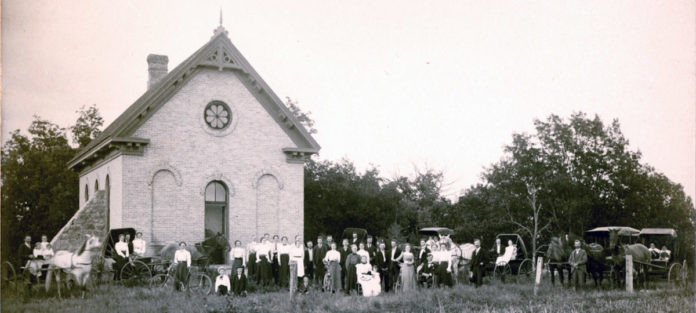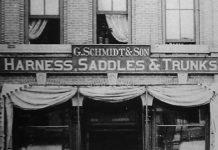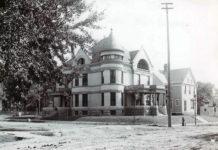Featured Image: Photo courtesy Cindy Slater – Yaeger School House, ca. 1900
Perched on a grassy green hill surrounded by a cluster of oak trees in Rapidan Township just east of Rapidan, is a brown brick school house. This school was established in 1867 as School District #91. The school became known as the Yaeger School, named after the Yaeger family who owned the land surrounding the building.
This little schoolhouse has a very interesting history because at one time it was thought to be “haunted”! Stories of the Yaeger schoolhouse ghost have become a part of local folklore passed down through the years.
Who was this ghostly thief? Who was this who could burn fires yet never heat the stove? Who could vanish so quickly into thin air? Who could never be seen or heard? It must be a ghost!
Newspaper accounts tell the story of what actually happened in 1897 when Eva Hower was the school teacher and the events began to unfold. The following is an account of the events as Eva may have told them if she were here today…
Teacher’s Point of View
I was the teacher at the Yaeger school house in 1897 when a series of strange events began to take place at the school and in the neighborhood.
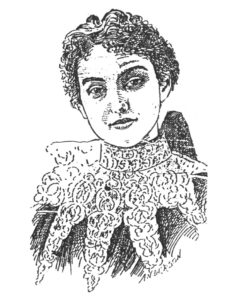
Several times when I arrived at the school house in the morning I found a window to the building was open. At first I didn’t pay too much attention to this. Then one Monday morning upon entering the school, I discovered men’s footprints on the floor and bits of paper scattered from one of the windows to the chimney. My students began to tell me stories about clothing that was missing from their mother’s clothesline, chickens were missing from their father’s chicken coop or that they woke in the morning to find their cow had been milked.
People all around the neighborhood were talking about these strange events and they were getting nervous.
Leona Holberg came to school one day and told me this story: “Mother and I were out near the corn crib when we heard a noise from the other side of the crib. We knew there must be a tramp or thief in the neighborhood, because everybody was losing stuff, ourselves included. Mother said, We’ve caught the thief now! You run around one side of the crib and I’ll go around the other. We ran around the crib from different sides – to find a black calf nibbling corn out of the crib.”
A Growing Mystery
Now that is how nervous people were. Every noise we heard, we thought a thief was on the place. Clothes for smaller persons, sheets, pillow cases and blankets were missing from clothes lines. Hams were missing from smokehouses and chickens and turkeys were taken from their roosts. Preserves and canned goods were missing from cellars with outside doorways.
The former state senator, William A. Just, owned a beautiful riding horse. One morning he found his horse coming down the road toward his home, tired and sweaty. The animal had been ridden hard. But there was no rider! Herman Miescke awoke to find his team, harness and wagon gone one morning. Later in the day the team came home, driverless, tired, and showing the signs of a hard, long trip.
These strange happenings kept on for months and months. At first people thought it was a very clever thief. But then stranger things began to happen.
John Ballard, one of my students who built the fire for the schoolhouse during the winter, told me that many times when he reached the building he saw smoke coming from the chimney, but he always found the stove cold. Sometimes he found the kindling he had prepared the night before was gone in the morning.
Could it Be a Ghost?
Some people thought all of this was some kind of a prank or a twisted joke, but when it continued for so long, they thought the joke had passed.
Carl Flo was the teacher here during the summer term. He told me that on the last day of the summer term he took a shortcut through the pasture leading by the schoolhouse. He saw smoke coming from the chimney. He knew there had not been a fire in the stove at school that day. So he went in to investigate and could find nothing wrong and the stove was COLD!
Of course the talk turned from a thief in the neighborhood to a ghost in the neighborhood! One day Lois Ballard, the youngest student in school, called down into the school basement, “Come out of there! We know you are in there!”
More and more things kept disappearing…tools, furniture, books from the school and pretty much anything you can think of. The newspapers reported clothing worth $1250 was stolen or missing from the Omaha freight house in Garden City and horse thieves broke into George Conklin’s barn at South Bend and stole a horse.
Who was this ghostly thief? Who was this who could burn fires yet never heat the stove? Who could vanish so quickly into thin air? Who could never be seen or heard? It must be a ghost!
Well, one day just as I was about to dismiss the students, Sheriff Dan Bowen arrived at the schoolhouse. I went to the door and saw Sheriff Bowen talking to Louis Yaeger, who had been plowing corn in front of the school.
Then the sheriff came to the door, “Miss Hower,” he said, “I have some very important news to share with you. Let’s go inside and sit down.” He began to tell me how he had solved the mystery of the Yaeger schoolhouse ghost.
Cyrus B. Miller
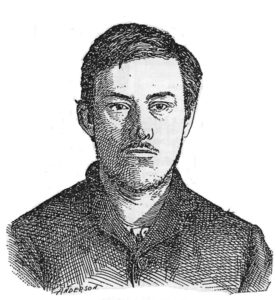
His story began when he received a description of Cyrus B. Miller (alias Silas Gary), an escaped convict from the Nebraska State Penitentiary in Lincoln. But weeks and months passed and the convict was not seen in Blue Earth County.
“Then one day I saw a little man, smooth shaven, alert, answering the description of the escaped prisoner and I set out in pursuit.” said Bowen. The trail led southeast of Mankato into dense woods and ended. Deputies were put on watch, yet the convict did not appear. Many more weeks later, the man appeared near the Omaha railroad tracks and again the sheriff gave chase. This time Miller crawled into a moving boxcar and rode away on the train.
I was very comfortable there.
“Now,” said the sheriff, “we all thought he was gone for good and forgot about him.” That is until Mankato merchants Perrin and Jensen reported the theft of a bright red bicycle.
A few days later, officers in Fairmont reported that a man had been seen riding a bright red bicycle. Guards were posted near the bridge where Miller had stashed his red bicycle and when he returned for it they arrested him.
Once in the custody of Sheriff Bowen, he was questioned. Where did he live? “Under the Yaeger schoolhouse,” he said. What? How long? “Eighteen months,” he said calmly. “I was very comfortable there.”
Right Beneath Our Feet!
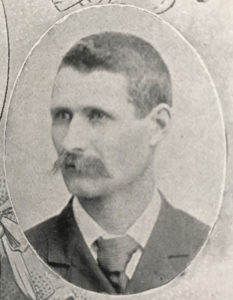
Then the sheriff walked over to my desk and moved it aside. To my surprise he found a trap door and he led me down to see me the ghost’s den. I couldn’t believe my eyes! All these months there was an escaped convict living beneath the schoolhouse! Overhead unknowing children did their sums, nor ever a thought a ghost lurked quietly beneath their feet!
But there I was, standing right in the middle of the ghosts’ den. It must have been about six feet by nine. On the west side there was a table and a cot with a buffalo robe, blankets and a pillow. On the east side was an oil heating stove and a writing desk. Dishes and cooking utensils were neat and orderly on shelves on the walls. The oil stove was attached to the schoolroom chimney to carry off the gas. The desk contained newspapers and many books from our school library and from the Mankato public library. A reflecting lamp hung on the wall that gave excellent light. There were rugs on the floor, pictures on the walls and the room was spic and span.
My, my Cyrus Miller was certainly a neat and orderly ghost!
Mystery Solved!
Sheriff Bowen continued to tell me the story of how Miller became the schoolhouse ghost.
Cyrus Miller, a small, dark complexioned 29 year-old man, came to the schoolhouse in the summer of 1896 when school was not in session. He used a skeleton key to open the door and went to work. He sawed a hole under the teacher’s desk at the south end of the room. Here a big oak sill, running the entire length of the room, was sawed through at three places to make his entrance. This weakened the floor but the ghost did not care, and the children did not know.
The room he carved out was about six and a half feet deep, with doors on the north and south sides. It was boarded up tightly and covered with fancy wallpaper.
The teacher’s desk stood on a platform raised about a foot from the floor and was not nailed down. Miller made a trap door along the seams of the boards and left no marks. Children often raised up the desk, but no one ever suspected a trapdoor.
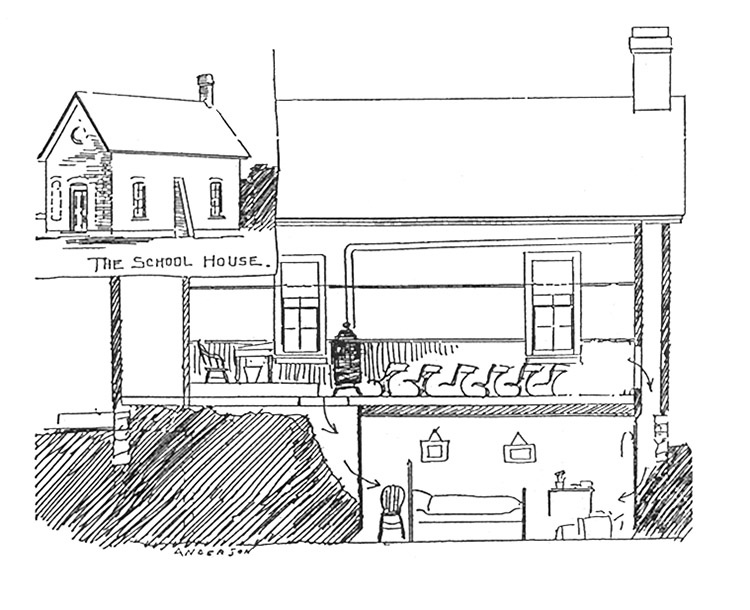
A three foot opening from the floor to the dirt beneath gave Miller plenty of room to work. Most of his work was done at night. The nearest house was the old Yaeger homestead about 60 rods away, so he was safe from interruption.
He labored for days digging a slanting tunnel and a room, which was under the north end of the school room. The room he carved out was about six and a half feet deep, with doors on the north and south sides. It was boarded up tightly and covered with fancy wallpaper.
The second entrance was made by removing the wainscoting around the chimneys at the north end of the room, and taking out the bricks. A weight attached to a pulley kept his improvised door tightly closed. The weight was two heavy chunks of wood in a gunny sack. These chunks of wood were imprinted with the name Eric Holberg, from whose farm they had been stolen.
10¢ Admission
Well, it didn’t take long and the word that the mystery of the schoolhouse ghost was solved and the ghost himself was laid by the heels. Crowds flocked to the school to see where he lived. Someone even asked for 10 cents admission. If anything, this swelled the crowds and in one day more than $10 was taken in. But, it developed that the revenue fell far short of covering the loss through the weakened floor, the broken chimney and the rest of the damage done by Cyrus Miller.
When no one was around he would come up, make himself at home in the school and play the organ!
I was very curious about the man who had inhabited the school house unbeknown to me and felt compelled to speak to him. So I went on down to the Mankato jail to see this Cyrus Miller.
He told me that on several occasions during school hours he watched the proceedings through a crack in the chimney entrance to his parlor below. He said only once did he get a good glimpse of my face.
He told me that in the evenings when no one was around he would come up, make himself at home in the school and play the organ! He also told me he always had plenty to eat, and that he never stole anything he couldn’t use himself.
Trial
When the trial came, Miller solved a great many mysteries in concise confessions to this theft, that ride or that burglary. According to his testimony, he stole from people far and near.
His father wrote to the judge in his son’s defense and stated that Cyrus had, at one time, been a school teacher and a dutiful son until a few years ago when he began to act peculiarly. His father thought he might be mentally deranged. However, the court did not take his father’s concerns into consideration and Judge Severance sentenced him to serve five years and six months in the state penitentiary at Stillwater and then finish his term in Nebraska.
Sheriff Bowen told me that Cyrus made no attempt to escape when he and his deputies escorted him to prison. “He told me he’ll make no attempt to escape from prison and when he’s discharged he’ll try to make a man of himself,” the sheriff said. “You know what else? He’s planning to write a book while he’s in prison, a history of his life. And he promised to send me one of the first copies.”
Well, I don’t know if he ever wrote a book or just what became of Cyrus Miller. But I’ll never forget the year I taught at the Yaeger school.
~~~
This article was revised from an article originally written by the author for the Blue Earth County Historian, Fall 2004 issue.
Authors Note: Eva Hower taught at the Yaeger school during the winter term. She became the head bookkeeper for the Mankato Telephone Company. Carl Flo taught the summer term at the school in 1897. Later he worked in the elevator and lumber business in Rapidan.
Sources: Mankato Daily Review, various 1897 issues, The Journal Magazine 1927, Good Thunder Herald 1928, and The Heritage of Blue Earth County, 1990.

